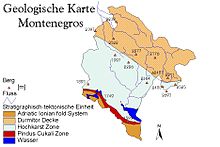High karst zone
The high karst blanket or high karst zone (English High Karst Unit or High Karst Zone) is a tectonic unit of the Balkan Peninsula. It is one of the outer units of the Dinarides (external Dinarides) on the edge of the Adriatic Plate . The outer areas of the Adriatic Plate are characterized by carbonate platforms from the Triassic to Cretaceous. Between the high karst zone and the Adriatic rim, there are narrow deep-sea facia called the Pindos-Oolonos zone in Greece, the Krasta-Cukali zone in Albania and the Budvazone in Montenegro.
geology
The tectonic unit consists of stratigraphic sequences that range from the Upper Cretaceous to the Mesozoic Carboniferous and the Eocene of the Cenozoic Paleogene. The deposits began with marine sediments from the Upper Cretaceous and Permian. In the Early Triassic, narrow marine carbonates and silica clasts were deposited as a sign of shelf conditions.
Deep-sea conditions prevailed in the Middle Triassic. In the late Triassic, the deposit conditions became shallower, whereupon the carbonate platform began to form. This lasted until the Eocene when flysch was deposited.
Limits
The Budva-Cukali zone, in which sediments of Triassic deep-sea facia up to flyschen of the Cenozoic era lie, separates the more external carbonate platforms of the Dalmatian zone from the high karst unit. However, it wedges in the north between Kotor and Dubrovnik. To the north of this, the Hochkarst unit and the Dalmatian zone can be separated by a thrust which can be traced northwest to Split. It then runs underground, where it interferes with the NS trending, winding Split-Karlovac fault.
In the north, the high karst zone is pushed over by the southern alpine zone. To the east of the Vorkarst unit and the Bosnian flysch. The high karst zone pushes over the Dalmatian zone in the west and the Budva-Cukali zone in the southwest. In the south, the unit is separated by the Skadar-Peć fault.
literature
- Schmid, SM, Bernoulli, D., Fügenschuh, B., Matenco, L., Schefer, S., Schuster, R., Tischler, M. & Ustaszewski, K. 2008: The Alpine-Carpathian-Dinaridic orogenic system: correlation and evolution of tectonic units. Swiss Journal of Geosciences 101 (1), p. 139-183.
Individual evidence
- ↑ Maksimilian Posavec 1968: Results of photogelogical-structural-geological interpretation of the SW areas of Croatia . Mitt. D. Geol. Ges. Wien 62: 40–45 (PDF)
- ↑ Schmid, SM, Bernoulli, D., Fügenschuh, B., Matenco, L., Schefer, S., Schuster, R., Tischler, M. & Ustaszewski, K. 2008: The Alpine-Carpathian-Dinaridic orogenic system: correlation and evolution of tectonic units. Swiss Journal of Geosciences 101 (1), p. 139-183.
